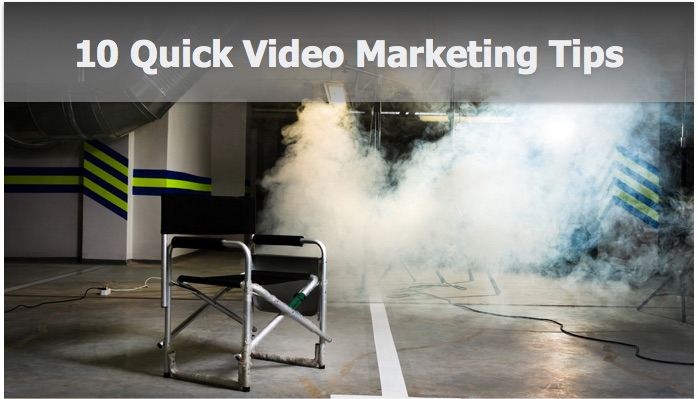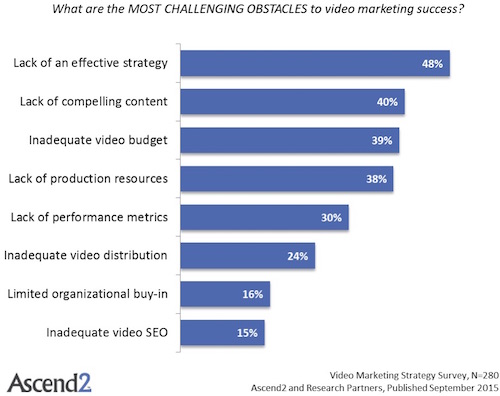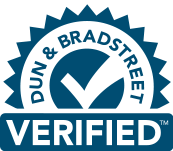Consumers today are constantly bombarded by ads. And they have incredible short attention spans to boot. That means it’s more challenging than ever before for marketers to draw audiences in and keep them entertained.
Thankfully, video is a great way to get just about anyone’s attention. But you need to do more than just have a video. That’s why I’ve put together a few quick tips to keep in mind, before you create and distribute your next video.
1. Start with a strategy
It’s easy to get excited about creating a fun video, but it will be difficult to find success if you haven’t defined what that looks like from the beginning.
In a recent survey conducted by Ascent2, the number one obstacle in video marketing success was the lack of an effective strategy.
What many marketers forget is that, just like any other marketing tactic or platform, you’ll first need to understand the rules of the game to get the best results. Always start with strategy, then move on to creation.
2. Think of a relevant and descriptive title
It seems simple enough, but a strong title is definitely the hook needed to get viewers to bite. The best title for your video will give the viewer an idea of what they will be watching, but it will also leave them wanting more. And be sure to put the main keywords at the beginning of the title. This is a great SEO trick, and it helps your audience as they browse.
3. Customize your video thumbnail for more clicks
It’s amazing how many marketers just go with the default thumbnail image. It’s among the first thing users see, and should shout, “watch me!” to your audience. The image you select also needs to be intriguing and relevant to your audience, giving them no choice but to want to play it. Which would you click on?
Pro-tip:
Try testing different thumbnails to see which gets the most click-throughs.
4. Cut your video to an appropriate length
When it comes to video, size does matter. And shorter is usually better. We see a dramatic drop-off in views at about 1:20. This means that you need to get to the point quickly and stay on point. This is especially true if someone is at the top of the buyer funnel (awareness stage) and is not yet committed to investing more time watching a video.
Have more information to provide? Easy. Create additional videos for those topics. Based on the views from these subsequent videos, you will have clues on what really interests your audience.
5. Give viewers next steps
After the viewer watches your video, what should they do next? This part is your “call to action,” and it should be clear and concise.
However, a call to action does not have to be, and usually shouldn’t be, a sales request. Asking the viewer to “buy now” is a sure way to make them go elsewhere. But providing recommendations for additional resources or suggesting more videos is a better way to create a delightful user experience, especially when you leverage in-video annotations, cards, buttons/links and contact forms.
6. Use the right video player for your needs
Many marketers and IT teams use YouTube, because it’s well known and free. However, “free” does not always mean “best.” Unless you have a large number of YouTube subscribers, a YouTube video player on your website is probably not the right approach. In fact, YouTube videos actually compete in search rankings with your website, and they can even rank above your website.
Instead, I frequently recommend Wistia, a cost-effective player that is packed with features marketers love, like detailed metrics. Others that you might consider are Invoto, BrightCove and Vidyard.
Pro tip:
No matter which player you choose, when it comes to sharing your video on social networks, always upload your video to the social network’s native video player for the best possible user experience and optimal social feed placement.
7. Get found by search engines and users
Include a great description, upload a video transcription, and add keyword tags. These often-overlooked steps will give you the highest likelihood of search engines understanding the video content and better allow viewers to find it.
Pro Tip:
Lately, longer descriptions have been ranking higher. Consider including a description of about 600 words.
8. Measure success not views
Video views do not correlate with business success. Most executives will want to know the impact on the business. Connect the video interactions with your marketing automation tool, web analytics and CRM. This will allow you to get to more important metrics like: leads per view, conversion rate increase and average deal size of those influenced by a particular video. Not to mention gathering great behavioral data like what topics buyers are interested in, which videos most often lead to purchase and which lead is hot.
9. Back off from sales
It’s a natural desire but resist it. Be informative and helpful to your audience. Provide information to intrigue them and a path for them to find out more if they are interested. But resist the sales pitch.
10. Have fun and a sense of humor
Video can be a lot of fun. Even if the message you are delivering seems dry or boring, find a way to make it fun. I saw a really great recently by Taulia. In multiple videos, they have taken a business topic that isn’t very exciting and have made a point through funny and entertaining videos that speak to key pain points of their audience. This is a very creative approach to using video marketing.
Some of the steps above may seem simple, but they’re all key to getting more views, engagement and success. Apply these insights to your next video, and let me know how it goes!







